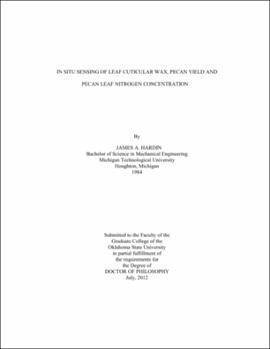| dc.contributor.advisor | Jones, Carol L. | |
| dc.contributor.author | Hardin, James Albert | |
| dc.date.accessioned | 2013-11-26T07:43:14Z | |
| dc.date.available | 2013-11-26T07:43:14Z | |
| dc.date.issued | 2012-07 | |
| dc.identifier.uri | https://hdl.handle.net/11244/6410 | |
| dc.description.abstract | Scope and Method of Study: | |
| dc.description.abstract | The objectives of this study were to develop technologies to enable in situ sensing of plant physiological conditions. | |
| dc.description.abstract | Cuticular wax on spinach leaves was quantified by applying an empirically developed regression relationship to Fourier transform infrared attenuated total reflectance (FTIRATR) spectra of fresh plant material. | |
| dc.description.abstract | In the second study, the backscatter response of microwaves from pecan tree canopy samples was investigated to assess the ability of short range radar to estimate nut yield in pecan orchards prior to harvest. | |
| dc.description.abstract | Finally, two methods to assess concentration of nitrogen in pecan leaves were developed. The first method extracted data from high resolution camera images in the green, red and near-infrared bands to calculate foliar nitrogen levels. In the second investigation, regression analysis was used to find relationships between chlorophyll meter measurements and chemical nitrogen analysis. | |
| dc.description.abstract | Findings and Conclusions: | |
| dc.description.abstract | Linear regression models derived from FTIR-ATR spectra were able to predict greater than 86% of wax variation on leaves using 4 or 5 frequencies. DSC did not provide reliable predictions of cuticular wax. | |
| dc.description.abstract | Measurements of short range microwave radiation from 1 to 18 GHz reflected from pecan tree canopy samples resulted in linear regression models that predicted total water and dry mass of the samples over a wide range of frequencies with R2 >0.63 and 0.78 respectively. | |
| dc.description.abstract | Normalized difference vegetative index (NDVI) and reflectance data extracted from the camera images were significantly correlated to foliar N in both months of the study on 'Pawnee' pecans but only in one month 'Kanza'. The various relationships had R2 between 0.21 and 0.51. Correlation of foliar N to chlorophyll meter readings was poor in May for all cultivars but distinct significant linear relationships were found for 'Maramec' and 'Pawnee' for each of the other months tested with R2 ranging from 0.40 to 0.87. Data from 'Kanza' had significant relationships in June and October with R2 of 0.39 and 0.72, respectively. | |
| dc.format | application/pdf | |
| dc.language | en_US | |
| dc.rights | Copyright is held by the author who has granted the Oklahoma State University Library the non-exclusive right to share this material in its institutional repository. Contact Digital Library Services at lib-dls@okstate.edu or 405-744-9161 for the permission policy on the use, reproduction or distribution of this material. | |
| dc.title | In situ sensing of leaf cuticular wax, pecan yield and pecan leaf nitrogen concentration | |
| dc.contributor.committeeMember | Bowser, Tim | |
| dc.contributor.committeeMember | Weckler, Paul | |
| dc.contributor.committeeMember | Maness, Niels O. | |
| osu.filename | Hardin_okstate_0664D_12235.pdf | |
| osu.accesstype | Open Access | |
| dc.type.genre | Dissertation | |
| dc.type.material | Text | |
| dc.subject.keywords | cuticular wax | |
| dc.subject.keywords | ftir-atr | |
| dc.subject.keywords | microwave | |
| dc.subject.keywords | nitrogen | |
| dc.subject.keywords | pecan | |
| dc.subject.keywords | sensing | |
| thesis.degree.discipline | Biosystems Engineering | |
| thesis.degree.grantor | Oklahoma State University | |
